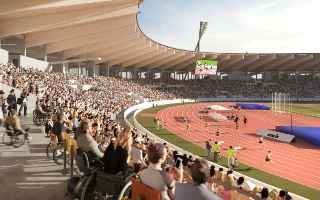Friedrich-Ludwig-Jahn-Sportpark
| Capacity | 20 000 |
|---|---|
| Country | Germany |
| City | Berlin |
| Clubs | – |
| Category | Design awaiting implementation |
| Cost | €168 M ($190 M) |
| Construction | 2026–2028 |
| Design | O+M Architekten |
Advertisement
Friedrich-Ludwig-Jahn-Sportpark – design description
What are the main features of the new Friedrich-Ludwig-Jahn-Sportpark project?
The main objective of the investment is to build a completely new stadium to replace the well-deserved Friedrich-Ludwig-Jahn-Sportpark. However, the new arena will be similar to its predecessor in many respects – it will be equipped with an athletics track, and the new stands will have a similar capacity of approximately 20,000 spectators.
The new facility will be more modern, environmentally friendly, and comfortable – worthy of its status as Berlin's third-largest stadium, ready to host high-profile events.
One of its most distinctive features will be a protruding red glass facade enveloping the entire building. This motif is intended to refer to the exterior of the modernist main stand at the old stadium.
Just behind the west stand, a section of the Berlin Wall will be preserved – it will not only be a historical memorial, but also an additional attraction enriching the surroundings. Two of the four characteristic lighting masts of the old facility will also be preserved.
Wide ramps will run along the stadium, allowing wheelchair users to access the stands.
The broader plan includes not only the reconstruction of the stadium, but also the revitalization of the entire complex of sports facilities in the area. The theme of the investment is to create an inclusive sports park, accessible to all and providing good conditions for athletes with disabilities.
The investment has its opponents – local residents who have launched a citizens' initiative have collected over 14,000 signatures against the demolition of the old stadium. When the demolition started in October 2024, it was suspended after less than a month due to... the protection of sparrows. After additional birdhouses were installed, work was conditionally resumed in early 2025.
The actual construction is to take place after the old facility has been completely demolished and is planned for 2026–2028. The cost of building the stadium is estimated at €168 million, with an additional €14 million for demolition work.
What does the old Friedrich-Ludwig-Jahn-Sportpark look like?
The Friedrich-Ludwig-Jahn-Sportpark was built in 1951 in East Berlin, right on the border with West Berlin. When the Berlin Wall was erected a decade later, its inner wall (the so-called Hinterlandmauer), separating the actual territory of the GDR from the border strip, ran along the earth embankment of the stadium's western stand, just behind the rows of seats (this section of the wall has been preserved to this day).
The facility was one of the most important stadiums in East Berlin. It was home to football clubs such as Vorwärts Berlin and Berliner FC Dynamo, winners of numerous GDR championship titles. The GDR Cup final was held here three times, and the GDR national team played 10 matches at the stadium.
World records in athletics were set in the arena, including the phenomenal feat of Uwe Hohn, who on July 20, 1984, threw a javelin at a distance of 104.8 m – as the first and only person to break the 100 m barrier. Hohn's achievement accelerated work on changing the parameters of the javelin, which shortened the throwing distances (introduced in 1986).
The venue also hosted the stage finishes of the Peace Race (1966–1977), a Michael Jackson concert (1992), Eurobowl (2014), Speedway Grand Prix (2001), the Women's Champions League final (2015) and the European Para Athletics Championships (2018).
The stadium has an athletics track surrounded by an oval ring of stands supported by earth embankments. The venue has a capacity of approximately 20,000 spectators and is the third largest stadium in Berlin (after the Olympic Stadium and the Union Berlin stadium). The stadium is the main element of a larger sports complex, and there is also a big sports hall (Max-Schmeling-Halle) right next to it.
The venue has been modernized several times, for example in 1964 it received artificial lighting, in 1970 a tartan running track, in 1986–1987 the main stand was expanded, the stand on the opposite side was roofed and the lighting masts were replaced, and in 1998 the auditorium was equipped with distinctive, coloured seats.
In the 21st century, the stadium is considered outdated, although there are many voices emphasizing its architectural and historical value. The modernist main stand building from the 1980s and the distinctive lighting masts are particularly noteworthy.
How did the plans to rebuild the Friedrich-Ludwig-Jahn-Sportpark come about?
A thorough reconstruction of the stadium and the entire sports complex began to be planned as early as 2013. In 2014, a feasibility study was commissioned by the Berlin authorities and carried out by Büro SportConzept. Another, updated study was carried out in 2020 by Drees & Sommer. A series of public consultations was held in 2021.
One of the main objectives of the modernization was to create an “inclusive sports park”, optimized for sports for people with disabilities and accessible to spectators with special needs.
The plans were initially developed with the Olympic Games in mind – Berlin was considering bidding to host the 2024 or 2028 Games, although these plans ultimately did not come to fruition.
During the planning stage, various options were considered, from modernizing the existing facility to building a new arena in a different location. Ultimately, it was decided that the old Friedrich-Ludwig-Jahn-Sportpark would be demolished, but the new facility would be built in exactly the same place.
In the spring of 2022, a competition was announced for the architectural design of the new stadium. Of the initial 24 entries, 15 were selected for the final phase. The best concept was selected during a jury meeting on December 13-14, 2022. The winning design was prepared by O+M Architekten in collaboration with LOR Landschaftsarchitekten (both companies are based in Dresden).
What is the concept behind the new Friedrich-Ludwig-Jahn-Sportpark?
Although the new stadium will be built from scratch to replace its predecessor, it will be a facility of similar size and characteristics – but more modern, comfortable, and inclusive. The stadium will be equipped with an athletics track, and the covered stands will accommodate 20,000 spectators.
The auditorium will consist of a single-level, oval ring of stands, this time not based on slopes, but made in the form of a reinforced concrete structure. There will be large screens in the corners, and two of the four characteristic lighting masts will be preserved on the outside.
A wide promenade is planned along the upper edge of the stands. It will be constructed in the form of a cantilever structure – raised above the ground and suspended over an open space.
On the outside, the promenade will be enclosed by a red-tinted glass wall, thus referring to the modernist main stand of the old stadium, where there was a similar protruding element covered with red glazing.
The sealed glass cover, reaching from floor to roof, will not only be a visual accent, but also an effective acoustic barrier, protecting the surrounding area from excessive noise emissions.
Wide ramps will runalong the perimeter of the stadium, providing wheelchair access to the stands. Behind the west stand, a section of the Berlin Wall will be preserved, serving not only as a historical memorial but also as an additional attraction, enriching the surroundings of the facility.
The main entrance to the stadium will be on the eastern side, where, due to differences in terrain height, the building's facade will be the highest. In this location, additional glazing and green elements will appear in the lower part of the facade.
What will the construction of the new Friedrich-Ludwig-Jahn-Sportpark bring?
Thanks to the investment, the aging Friedrich-Ludwig-Jahn-Sportpark will give way to a modern, eco-friendly arena, befitting the status of the third-largest stadium in the German capital. Although it will be a completely new structure, it will retain the proportions and character of the old facility, emphasizing the continuity of the place.
The new stadium will provide excellent conditions for hosting top-level events — from athletics, football or rugby, to American football and cultural events.
Located relatively close to the city center, in a densely populated area near the popular Mauerpark, the stadium has the potential to attract a wide range of activities. As a medium-sized facility, it can also host events that are too small for the Olympic Stadium.
Much attention will be paid to sports for people with disabilities and ensuring full accessibility of the stadium. The modernization of the entire complex aims to create an inclusive sports park, accessible to local residents and people with disabilities.
When will the new Friedrich-Ludwig-Jahn-Sportpark be built?
The investment is planned in three phases. The first phase involves the demolition of the old stadium, the second phase involves the construction of the new stadium, and the third phase involves the revitalization of the remaining part of the complex.
How much will the construction of the new Friedrich-Ludwig-Jahn-Sportpark cost?
The construction of the stadium is expected to cost €182 million (including €14 million for the demolition of the old facility), and together with the revitalization of the entire complex, the investment is estimated to cost €263.4 million.
Who protested against the construction of the new Friedrich-Ludwig-Jahn-Sportpark?
The investment also has its opponents. Local residents who demanded that the old stadium be preserved launched a citizens' initiative (Bürgerinitiative Jahnsportpark) and collected over 14,000 signatures.
Opponents argued that the stadium is a well-preserved example of modernist architecture from the communist era and should be modernized instead of being demolished.
There were also concerns about the negative impact of the investment on the natural environment, the potential felling of trees, and the threat to the animal species living there. The NaturFreunde Berlin association also opposed the construction.
When did the demolition of the old Friedrich-Ludwig-Jahn-Sportpark begin?
Demolition of the old stadium began on October 8, 2024, starting with the main stand. In addition, plastic seats from the stands were available for free to interested individuals and organizations.
Why was the demolition of the old Friedrich-Ludwig-Jahn-Sportpark halted?
Less than a month after demolition began, on November 4, work was halted by a court decision that granted a request for interim measures filed by NaturFreunde Berlin.
The reason for the suspension of work was the threat to a protected species, the house sparrow – continuing the demolition could have led to the destruction of at least 94 nesting sites.
When was the demolition of the old Friedrich-Ludwig-Jahn-Sportpark resumed?
Bird nesting boxes were set up around the stadium, and in January 2025, permission was granted to continue demolition, but only of the main stand. Work resumed on January 27, 2025.
When will the new Friedrich-Ludwig-Jahn-Sportpark be built?
The construction of the new stadium is to take place after the demolition of the old facility and is planned for 2026–2028. The revitalization of the entire complex is expected to last until 2030.
Advertisement
Renderings
-
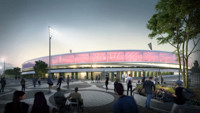
2024 © O+M Architekten 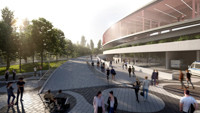
2024 © O+M Architekten 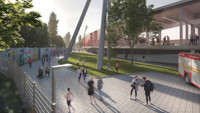
2024 © O+M Architekten 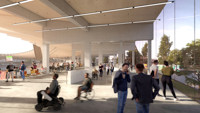
2024 © O+M Architekten 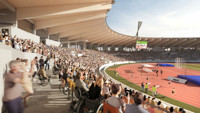
2024 © O+M Architekten 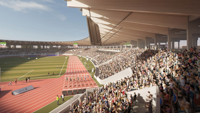
2024 © O+M Architekten 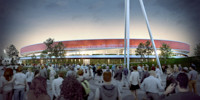
2022 © O+M Architekten 
2022 © O+M Architekten
2022:
Related news
2025
2024
-
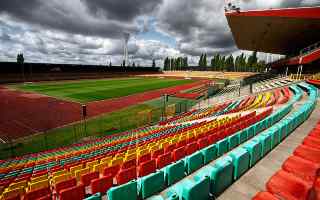
Germany: Demolition of Berlin's third largest stadium
One of Berlin’s largest stadiums is set to be demolished, a move many find absurd and are currently opposing. An urgent request has been submitted to the Administrative Court regarding the controversial demolition work in the historic Friedrich-Ludwig-Jahn-Sportpark.
-
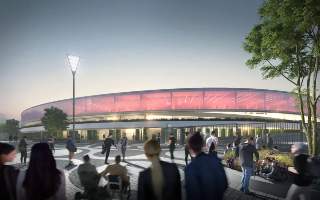
Germany: Architects protest against demolition of Jahnsportpark
In 2022, a stadium design was chosen to provide regional football clubs with a modern sports facility suitable for second and third division German matches. The investment plan includes demolishing the existing Jahnsportpark and building a new arena. However, opposition to the disappearance of the old stadium is growing.
-
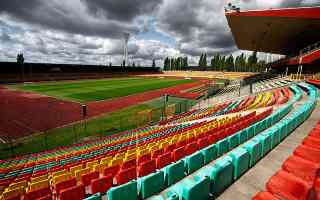
Germany: What's happening with stadium construction in Berlin? High costs deter investment
Plans have been in the works for some time to build a brand new Friedrich-Ludwig-Jahn-Sportpark in Berlin. The project involves demolishing the old facility and constructing a new 20,000-seat arena. This stadium will be the third largest in the German capital, following the Olympic Stadium and Alte Försterei.
-

Berlin: Stadium construction costs over 70% more. What's next for investment?
In 2022, a stadium project was selected to provide regional football clubs with a modern sports facility suitable for second and third league German competitions. The vision of O + M Architects and landscape architects Otto + Richter involves demolishing the existing Jahnsportpark and constructing a new arena.
 StadiumDB
StadiumDB